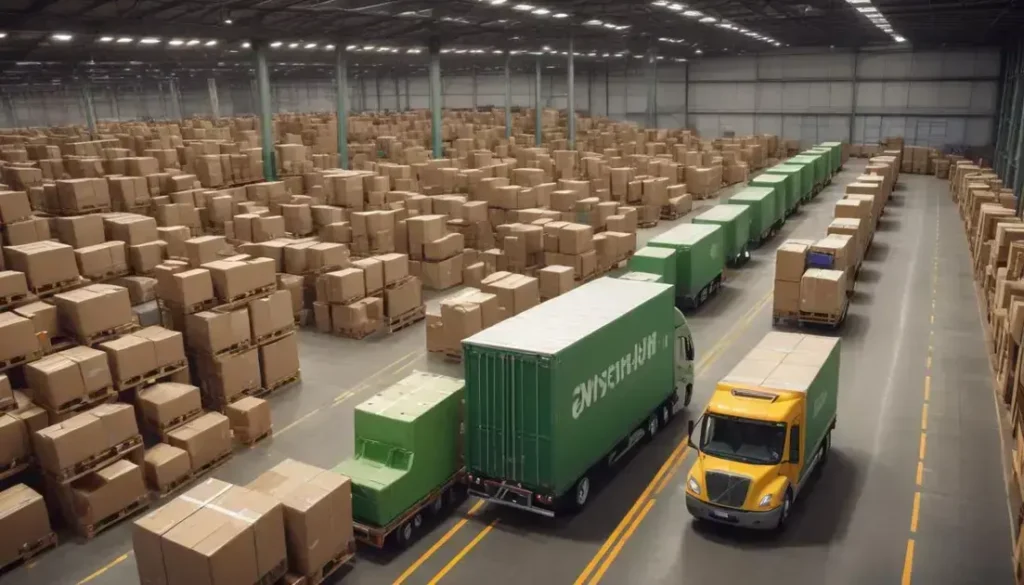Scope 3 emissions refer to the indirect emissions produced in a company’s value chain, crucial for comprehensive sustainability strategies as they often represent the largest share of total emissions, making their management essential for achieving net-zero goals.
Scope 3 emissions represent a significant challenge for businesses today, especially in the context of sustainability management. Have you ever wondered how this impacts your operations?
Understanding Scope 3 emissions
Understanding Scope 3 emissions is crucial for businesses committed to enhancing their sustainability practices. These emissions are indirect and arise from a company’s supply chain activities, including both upstream and downstream operations. Unlike Scope 1 and Scope 2, which deal with direct emissions and those from purchased energy, Scope 3 encompasses a broader view of the entire value chain.
Calculating Scope 3 emissions can be complex, as it involves analysing various aspects such as raw material extraction, transportation, product use, and end-of-life disposal. Each of these elements contributes significantly to a company’s overall carbon footprint, making transparency essential.
For Australian businesses, addressing these emissions can lead to tangible benefits, such as improved efficiency and cost savings. Engaging with suppliers to understand their practices not only helps in measurement but can also foster collaboration towards reducing emissions collectively. Additionally, companies with lower Scope 3 emissions can enhance their reputation and meet the rising expectations of consumers and investors who are increasingly seeking environmentally responsible businesses.
Ultimately, effectively managing Scope 3 emissions will not only mitigate climate impacts but also position businesses strategically within the market, preparing them for future regulations and consumer demands.
The partnership between Capgemini, Thales & Sweep
The partnership between Capgemini, Thales, and Sweep marks a significant collaboration aimed at addressing the challenges of Scope 3 emissions. Together, these industry leaders are leveraging their strengths to drive innovation in sustainability practices across various sectors. By combining Capgemini’s expertise in digital transformation with Thales’ advanced technologies and Sweep’s carbon management solutions, they are creating a formidable approach to emissions reduction.
This partnership focuses on devising comprehensive strategies that enable businesses to effectively measure, manage, and reduce their carbon footprints. The integration of cutting-edge technology facilitates real-time data analytics, allowing companies to gain insights into their supply chains and identify areas for improvement. This collaborative effort not only enhances operational efficiency but also promotes transparency in emissions reporting.
As Australian businesses increasingly face pressure from regulators and consumers to adopt sustainable practices, this partnership provides a valuable resource. It enables companies to benchmark their progress and implement best practices aligned with global standards. Together, Capgemini, Thales, and Sweep are setting a precedent for how corporate alliances can achieve significant environmental impact while supporting economic growth.
Ultimately, this collaboration exemplifies a forward-thinking approach to corporate responsibility, encouraging other companies to take action in their journey towards net-zero emissions.
Why Scope 3 emissions matter for Australian businesses
Why Scope 3 emissions matter for Australian businesses can’t be overstated. These emissions, which encompass all indirect emissions in a company’s value chain, play a crucial role in overall sustainability efforts. They often represent the largest portion of a company’s carbon footprint, especially for industries heavily reliant on supply chains.
Addressing Scope 3 emissions is essential for companies seeking to enhance their environmental, social, and governance (ESG) performance. By understanding and managing these emissions, Australian businesses can not only comply with increasing regulatory requirements but also respond to growing consumer demand for transparency and accountability.
Moreover, focusing on Scope 3 emissions can unveil hidden inefficiencies within supply chains. This can lead to decreased costs and enhanced operational performance as initiatives to reduce emissions often align with process improvements and waste minimisation.
For many Australian companies, engaging with suppliers to reduce Scope 3 emissions fosters collaboration and innovation. It encourages suppliers to adopt sustainable practices, creating a ripple effect that extends throughout the supply chain. By actively working on these emissions, businesses can differentiate themselves in a competitive market, attract investment, and enhance their brand reputation among environmentally conscious consumers.
Methods to measure Scope 3 emissions
Methods to measure Scope 3 emissions are essential for companies aiming to understand their environmental impact better. These emissions are often complex to quantify due to their indirect nature, arising from various sources within the supply chain.
One common method involves using the Greenhouse Gas Protocol, which provides comprehensive guidelines for measuring emissions from all scopes, including Scope 3. This protocol allows businesses to categorise their emissions into 15 distinct categories, making it easier to identify specific areas for reduction. Categories include purchased goods and services, capital goods, and waste generated.
Another effective approach is conducting a life cycle assessment (LCA). This method evaluates the total environmental impact of a product throughout its entire life cycle—from raw material extraction to disposal. By implementing LCA, companies can pinpoint critical phases where emissions are generated and target those areas for improvement.
Additionally, engaging with suppliers to gather data on their emissions can enhance accuracy. Collaboration is key, as many suppliers may already have practices in place for measuring and reporting their own emissions.
Utilising technology, such as data analytics and software solutions, further streamlines the measurement of Scope 3 emissions, allowing for more precise tracking. Overall, these methods empower Australian businesses to take informed actions towards reducing their carbon footprint.
Challenges faced in tracking Scope 3 emissions
Tracking Scope 3 emissions presents numerous challenges for businesses aiming to enhance their sustainability practices. One of the main obstacles is the lack of standardisation in data collection methods across different industries. This inconsistency makes it difficult for companies to compare emissions data and establish benchmarks.
Another significant challenge is the availability of accurate data from suppliers. Many businesses rely on their suppliers to provide essential emissions information, but not all suppliers may have the capacity or willingness to share this data. This gap can lead to underreporting or inaccurate assessment of a company’s overall carbon footprint.
Additionally, the complexity of supply chains contributes to difficulties in emissions tracking. Multi-tiered supply chains often involve numerous stakeholders, making it challenging to obtain comprehensive data covering all aspects of the value chain. Companies may struggle to monitor emissions from every supplier, particularly those located in different regions with varying regulations.
Furthermore, businesses may encounter limitations in analytical capabilities. Without access to advanced analytics and technology, organisations can find it hard to effectively process and interpret emissions data, leading to missed opportunities for reduction.
Ultimately, overcoming these challenges requires a concerted effort from businesses to establish clear communication with suppliers, invest in data management systems, and adopt standard methodologies for emissions reporting.
Strategies for reduction across supply chains
Strategies for reduction across supply chains are vital for businesses looking to minimise their Scope 3 emissions. One effective approach is to engage suppliers in discussions about sustainability practices. By fostering open communication, companies can encourage suppliers to adopt eco-friendly measures, which can significantly reduce the overall emissions within the supply chain.
Another strategy involves implementing circular economy principles. This approach prioritises resource efficiency and seeks to keep materials in use for as long as possible. By designing products for longevity, reuse, and recycling, businesses can substantially lower their emissions associated with raw material extraction and waste.
Investing in technology can also play a critical role in emissions reduction. Advanced data analytics allow companies to monitor their supply chains more effectively, identify hotspots of carbon emissions, and make informed decisions about where to focus reduction efforts. Implementing software that tracks and reports emissions helps in maintaining transparency and accountability.
Collaboration is key; businesses should consider partnering with initiatives that promote sustainable practices across their industries. Joining forces with other companies can amplify efforts to influence suppliers and drive systemic change. Furthermore, industry standards and benchmarks can help companies assess their performance and find areas for improvement.
The role of technology and data analytics
The role of technology and data analytics in measuring and managing Scope 3 emissions is increasingly vital for businesses pursuing sustainability goals. Advanced analytics tools enable companies to gather, analyse, and interpret vast amounts of data efficiently. This ensures a more accurate assessment of emissions across the entire supply chain.
Utilising software solutions specifically designed for carbon accounting allows organisations to track emissions in real time. These solutions can integrate data from various sources, providing a comprehensive view of supply chain emissions and identifying key areas for reduction. With precise data at their disposal, companies can make informed decisions and implement targeted initiatives.
Moreover, machine learning algorithms can predict emissions trends based on historical data, helping businesses to forecast future emissions. This proactive approach allows companies to adapt their strategies, allocate resources effectively, and engage suppliers in reducing their carbon footprints.
Collaboration platforms also play a crucial role, enabling seamless communication between businesses and their suppliers. By sharing data and insights, all stakeholders can work together towards common sustainability objectives.
Ultimately, leveraging technology and data analytics not only enhances transparency but also builds credibility with consumers and investors who demand accountability in corporate sustainability practices.
Insights from Thales’ sustainability initiatives
Insights from Thales’ sustainability initiatives provide valuable lessons for businesses aspiring to improve their environmental performance. Thales has implemented a comprehensive strategy focusing on reducing its carbon footprint across all operations. One key aspect is their commitment to transparency in reporting emissions data, which builds trust among stakeholders.
The company employs innovative technology to enhance its sustainability efforts. By integrating data analytics with sustainability practices, Thales can monitor real-time emissions and identify areas for improvement within its supply chain. This data-driven approach allows for greater accountability and aids in achieving specific emissions reduction targets.
Thales also emphasizes collaboration with suppliers, advocating for sustainable practices throughout the supply chain. By engaging partners in their sustainability initiatives, they create a collaborative environment that promotes shared goals and practices, ultimately leading to a significant decrease in Scope 3 emissions.
Moreover, Thales has embraced circular economy principles, looking for ways to minimise waste and enhance resource efficiency. Their initiatives not only advance their sustainability agenda but also align with global trends towards environmental responsibility.
Overall, Thales’ proactive measures and focus on innovation serve as a model for other companies seeking to achieve their sustainability objectives while navigating the complexities of modern supply chains.
Capgemini’s approach to corporate sustainability
Capgemini’s approach to corporate sustainability is rooted in a commitment to innovation and responsibility. The company actively integrates sustainability into its core business strategy, recognising the importance of addressing climate change while driving business growth. By leveraging their expertise in technology and consulting, Capgemini helps clients not only meet regulatory requirements but also achieve their sustainability goals.
One of the key initiatives is the establishment of a comprehensive carbon reduction framework. This framework guides organisations in measuring, managing, and reducing their carbon footprint effectively. By employing advanced data analytics, Capgemini identifies emission hotspots within client operations, enabling targeted actions for reduction.
Furthermore, Capgemini collaborates with various stakeholders, including suppliers, customers, and policymakers, to promote sustainable practices across the supply chain. This collaborative effort fosters innovation and aligns sustainability goals with business objectives, creating a win-win scenario for all parties involved.
Capgemini also prioritises sustainable technology solutions, aiming to transform how businesses operate. This includes initiatives to enhance energy efficiency, reduce waste, and improve resource management. Through these efforts, Capgemini demonstrates that sustainability is not only a moral obligation but also a strategic advantage in today’s marketplace, helping organisations navigate the complexities of environmental challenges.
Opportunities for Australian exporters
Opportunities for Australian exporters are becoming increasingly significant as global demand for sustainable products rises. With the emphasis on reducing carbon footprints, Australian companies have the chance to expand their markets by promoting environmentally friendly goods and services.
One prime opportunity lies in the agricultural sector, where Australian farmers are well-positioned to export organic and sustainably produced commodities. International consumers are willing to pay a premium for products that align with their values, making this an advantageous market for exporters.
Additionally, the emergence of green technologies presents new avenues for businesses. Australian exporters can innovate and deliver solutions that meet the growing demand for renewable energy sources, waste management systems, and energy-efficient products. This not only meets local regulatory requirements but also strengthens their competitive position globally.
Furthermore, trade agreements with key partners in the Asia-Pacific region provide a framework for Australian exporters to enter new markets with favorable conditions. Leveraging these agreements encourages collaboration and offers businesses access to a larger customer base.
Finally, as sustainability becomes a key consideration for consumers and businesses alike, Australian firms that embrace sustainable practices will enhance their brand reputation, attracting partnerships and investment opportunities that further support growth.
The future of emissions reduction in Australia
The future of emissions reduction in Australia is poised for significant transformation as businesses and governments ramp up their sustainability efforts. With increasing awareness of climate change, there is a strong push towards achieving net-zero emissions by 2050. This ambitious goal aligns with international commitments and reflects the growing expectation from consumers and investors for responsible environmental practices.
One of the key strategies for emissions reduction involves embracing innovative technologies. Australia is investing in renewable energy sources like solar and wind, which are becoming more cost-effective and widely adopted. This shift not only reduces reliance on fossil fuels but also creates new job opportunities in green sectors.
Additionally, advancements in energy efficiency and sustainable practices within industries could dramatically lower emissions. Companies are increasingly adopting circular economy principles, focusing on resource conservation, recycling, and waste reduction. These efforts contribute to lowering carbon footprints while enhancing operational efficiency.
Collaboration between the public and private sectors will also be crucial. By establishing robust partnerships, businesses can leverage resources and expertise to implement effective emissions reduction strategies. Regulatory frameworks and incentives will support these initiatives, ensuring a collective effort towards a sustainable future.
Ultimately, Australia’s commitment to emissions reduction reflects its responsibility to combat climate change while positioning itself as a leader in sustainability on the global stage.
In conclusion, embracing sustainability is crucial for the future of Australian businesses
As we strive to reduce carbon emissions, it is clear that there are many opportunities for growth and innovation. By investing in green technologies and sustainable practices, businesses not only contribute to the well-being of the planet but also open the door to new markets.
The collaboration between companies, suppliers, and governments is essential. Together, we can develop effective strategies to reduce emissions and enhance the overall environmental impact.
Australia’s commitment to achieving net-zero emissions is a shared responsibility, and by taking active steps now, we can create a healthier, more sustainable future for generations to come.
Ultimately, prioritising sustainability will not only benefit our environment but also strengthen our economy and improve quality of life for all Australians.
Frequently Asked Questions
What are Scope 3 emissions, and why are they important?
Scope 3 emissions are the indirect emissions that occur in a company’s value chain, including those from suppliers and product use. They are crucial because they often represent the largest portion of a company’s total emissions.
How can Australian exporters benefit from sustainability practices?
Australian exporters can tap into international markets that demand sustainably produced goods. By adopting environmentally friendly practices, they can attract consumers willing to pay a premium for such products.
What are some effective strategies for reducing emissions in supply chains?
Key strategies include engaging suppliers in sustainability efforts, implementing circular economy principles, and leveraging technology to monitor and manage emissions effectively.
What role does technology play in carbon footprint reduction?
Technology, including data analytics and advanced tracking software, helps businesses measure their emissions accurately, identify reduction opportunities, and track progress in real-time.
Why is collaboration important in achieving sustainability goals?
Collaboration allows businesses to pool resources, share best practices, and align their sustainability initiatives, which can lead to more significant impacts and successful outcomes.
How can businesses prepare for the future of emissions reduction in Australia?
Businesses can prepare by investing in renewable energy, adopting innovative technologies, and actively engaging in sustainability practices that align with national and global emissions reduction targets.


